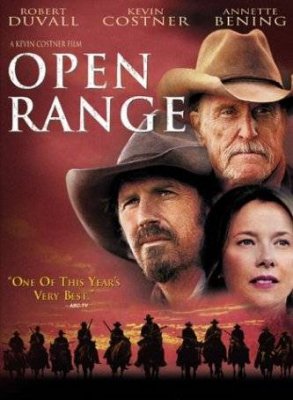Renz
An Army of One
Synopsis by Amazon.com:
Released almost exactly 11 years after Clint Eastwood's Unforgiven, Kevin Costner's Open Range proved yet again that the Western is the classic American genre. While it lacks the thematic impact of Eastwood's masterpiece, Costner's first film since 1997's ill-fated The Postman returns the actor/director of Dances With Wolves to the open prairies of America--in this case the free-range frontier of 1882--where legal "free-grazing" cattle drives were falling prey to empire-building land-owners. In the wake of territorial murder, free-grazing cowboys Boss (Robert Duvall) and Charley (Costner) seek vengeful justice against the ruthless rancher (Michael Gambon) who threatens their law-abiding survival. A feisty ally (the late Michael Jeter, in his next-to-final film role) and a doctor's sister (Annette Bening) offer support during climactic shootouts, masterfully staged with the shock and suddenness of real-life gunfire. Rich in character development and thick-hided humor, this handsome production redeemed Costner's directorial career with a well-told story (by Craig Storper, based on Lauran Paine's novel The Open Range Men), flawless performances, and stunning Canadian locations.
One of my favorite Westerns. I was a bit skeptical because I hadn't liked much of Costner's recent directorial work, but this film is a classic. The performances are all fantastic. Robert Duvall steals every scene with his frontier vernacular and his determination not to be pushed around by the cattle barons.
What really struck me in this movie was the realism. The gunfights take place at close range and many shots need to be fired before someone is hit. When people are hit by bullets or shotguns, then they look like they've been hit by a sledgehammer.
The town itself seems real also. A rainstorm turns the main street into a raging river, buildings collapse and the streets are filled with mud.
This is a well made film with a classic story of the underdogs fighting for their way of life against corrupt officials and wealthy landowners.
Released almost exactly 11 years after Clint Eastwood's Unforgiven, Kevin Costner's Open Range proved yet again that the Western is the classic American genre. While it lacks the thematic impact of Eastwood's masterpiece, Costner's first film since 1997's ill-fated The Postman returns the actor/director of Dances With Wolves to the open prairies of America--in this case the free-range frontier of 1882--where legal "free-grazing" cattle drives were falling prey to empire-building land-owners. In the wake of territorial murder, free-grazing cowboys Boss (Robert Duvall) and Charley (Costner) seek vengeful justice against the ruthless rancher (Michael Gambon) who threatens their law-abiding survival. A feisty ally (the late Michael Jeter, in his next-to-final film role) and a doctor's sister (Annette Bening) offer support during climactic shootouts, masterfully staged with the shock and suddenness of real-life gunfire. Rich in character development and thick-hided humor, this handsome production redeemed Costner's directorial career with a well-told story (by Craig Storper, based on Lauran Paine's novel The Open Range Men), flawless performances, and stunning Canadian locations.
One of my favorite Westerns. I was a bit skeptical because I hadn't liked much of Costner's recent directorial work, but this film is a classic. The performances are all fantastic. Robert Duvall steals every scene with his frontier vernacular and his determination not to be pushed around by the cattle barons.
What really struck me in this movie was the realism. The gunfights take place at close range and many shots need to be fired before someone is hit. When people are hit by bullets or shotguns, then they look like they've been hit by a sledgehammer.
The town itself seems real also. A rainstorm turns the main street into a raging river, buildings collapse and the streets are filled with mud.
This is a well made film with a classic story of the underdogs fighting for their way of life against corrupt officials and wealthy landowners.



